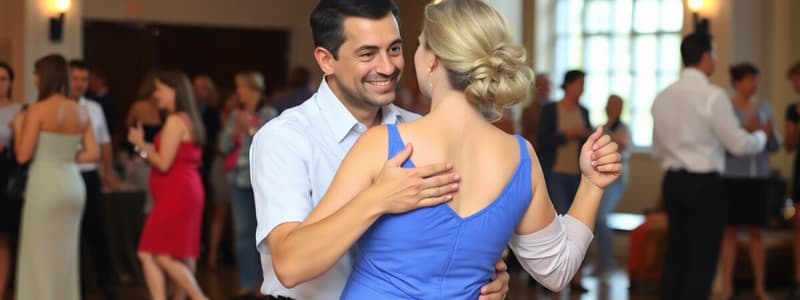Podcast
Questions and Answers
What characterizes the Smooth style of ballroom dance?
What characterizes the Smooth style of ballroom dance?
- Dances that incorporate acrobatic movements
- Dances that move around the dance floor in a counter-clockwise direction (correct)
- Dances that remain in one spot on the floor
- Dances that have a fast tempo only
Which of the following is NOT an example of Latin/Rhythm style of dance?
Which of the following is NOT an example of Latin/Rhythm style of dance?
- Rumba
- Viennese Waltz (correct)
- Salsa
- Cha Cha
When did the popularity of competitive ballroom dancing begin?
When did the popularity of competitive ballroom dancing begin?
- Late 18th century
- Early 1920s (correct)
- Late 19th century
- Early 1900s
What is the origin of the word 'Ballroom'?
What is the origin of the word 'Ballroom'?
Who was primarily associated with ballroom dancing in the late 18th and 19th centuries?
Who was primarily associated with ballroom dancing in the late 18th and 19th centuries?
Which of the following styles is NOT part of International Latin ballroom dancing?
Which of the following styles is NOT part of International Latin ballroom dancing?
When did cheerdance first emerge as part of cheerleading events?
When did cheerdance first emerge as part of cheerleading events?
What was the primary purpose of cheerleading?
What was the primary purpose of cheerleading?
Which component is excluded in cheerdance performances?
Which component is excluded in cheerdance performances?
In what decade did organized all-male cheerleading begin in the United States?
In what decade did organized all-male cheerleading begin in the United States?
Which of the following is NOT a component of cheerleading performances?
Which of the following is NOT a component of cheerleading performances?
How did cheerleading influence from Great Britain manifest in the United States?
How did cheerleading influence from Great Britain manifest in the United States?
In which decade did women begin to participate as cheerleaders?
In which decade did women begin to participate as cheerleaders?
Which International Standard ballroom dance is characterized by a smooth, flowing style?
Which International Standard ballroom dance is characterized by a smooth, flowing style?
Which dance style is specifically required for the World School Cheer Dance Championship?
Which dance style is specifically required for the World School Cheer Dance Championship?
What is NOT considered a basic gymnastics skill in cheer dance?
What is NOT considered a basic gymnastics skill in cheer dance?
Which element is NOT a part of the jumping technique in cheer dance?
Which element is NOT a part of the jumping technique in cheer dance?
What formation is described as resembling bowling pins?
What formation is described as resembling bowling pins?
What is the primary purpose of cheer motions?
What is the primary purpose of cheer motions?
Which cheer dance competition does NOT require a specific dance style?
Which cheer dance competition does NOT require a specific dance style?
Which of the following is an element of the jump technique?
Which of the following is an element of the jump technique?
Flashcards
Ballroom Dancing
Ballroom Dancing
Partner dances performed to music, using step patterns and rhythms that match the song's character.
Smooth Ballroom Style
Smooth Ballroom Style
Flowing dances performed around the dance floor, typically counter-clockwise.
Latin/Rhythm Style
Latin/Rhythm Style
Energetic dances performed in one spot on the dance floor, matching the music's rhythm.
Origin of "Ballroom"
Origin of "Ballroom"
Signup and view all the flashcards
Ballroom Dancing Popularity
Ballroom Dancing Popularity
Signup and view all the flashcards
Ballroom Standard Styles
Ballroom Standard Styles
Signup and view all the flashcards
Ballroom Latin Styles
Ballroom Latin Styles
Signup and view all the flashcards
Cheerdance
Cheerdance
Signup and view all the flashcards
Cheerleading
Cheerleading
Signup and view all the flashcards
Cheerleading History
Cheerleading History
Signup and view all the flashcards
Cheerleader squad
Cheerleader squad
Signup and view all the flashcards
Purpose of Cheerleading
Purpose of Cheerleading
Signup and view all the flashcards
Early Cheerleading
Early Cheerleading
Signup and view all the flashcards
Cheer Dance Elements
Cheer Dance Elements
Signup and view all the flashcards
Dance Techniques
Dance Techniques
Signup and view all the flashcards
Cheers
Cheers
Signup and view all the flashcards
Basic Gymnastics Skills
Basic Gymnastics Skills
Signup and view all the flashcards
Jump Stages
Jump Stages
Signup and view all the flashcards
Tumbling
Tumbling
Signup and view all the flashcards
Bowling Pin Formation
Bowling Pin Formation
Signup and view all the flashcards
Staggered Line Formation
Staggered Line Formation
Signup and view all the flashcards
Study Notes
Ballroom Dancing
- Ballroom dancing is a set of partner dances performed to music.
- It uses step-patterns and rhythms that match the song's character.
- It's a social and competitive activity suitable for all ages.
- Basic skills are needed for participation but are not necessary for social enjoyment.
- Can be enjoyed on stage, film, and television.
- Can be a healthy lifestyle choice.
- Two main types:
- Smooth style (flowing patterns, counter-clockwise): Fox Trot, Waltz, Tango, Viennese Waltz, Quickstep.
- Latin/Rhythm style (energetic, staying in one place): Swing, Rumba/Bolero, Cha Cha, Salsa/Mambo, Merengue, Disco/Hustle, Samba, Paso Doble.
- Ballroom dancing's popularity with the upper classes increased in the late 18th and 19th centuries.
- Competitive ballroom dancing's popularity started in the early 1920s.
- The Imperial Society of Dance Teachers standardized ballroom dances.
Cheerleading
-
Cheerleading emerged in the early 1990s as part of cheerleading events.
-
It combines dance techniques with basic cheerleading elements.
-
It excludes advanced gymnastics moves.
-
It focuses on crowd motivation, audience entertainment, or competition.
-
Performances include cheers, jumps, dance, gymnastics, and stunting.
-
Cheerleaders, dancers, and athletes involved are called cheerleaders.
-
Cheerleading has strong ties to sports events' history and the development of crowd participation.
-
Early cheerleading, developed in the 1860s by British students, and later spread to America.
-
Organized cheerleading began in 1898 at the University of Minnesota.
-
Dance routines:
- Techniques: contemporary, jazz, hip-hop, modern, ballet, and ethnic/folk dance.
- Specific dance styles may be required depending on the competition.
-
Cheer routines:
- Choreographed words and movements relating to an athletic event.
- Motions to lead spectators and encourage response.
- Basic gymnastics skills, including jumps and tumbling.
-
Jumps: Approach, lifting, executing the jump at its highest.
-
Tumbling: Forward/backward rolls, cartwheels.
-
Key facts:
- Cheerleading evolved as an integral component of sports.
Studying That Suits You
Use AI to generate personalized quizzes and flashcards to suit your learning preferences.





